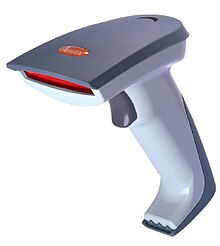Barcode reader

A barcode reader (or barcode scanner) is a computer peripheral for reading barcodes printed on various surfaces. Like a flatbed scanner, it generally consists of a light source, a lens and a photo conductor translating optical impulses into electrical ones. Additionally, nearly all barcode readers currently produced contain decoder circuitry analyzing the barcode's image data provided by the photo conductor and sending the barcode's content to the scanner's output port.
Types of barcode readers
Many different types of barcode scanners are available. They can be distinguished as follows:
By light source
- LED scanners : also referred to as CCD scanners -- even though the CCD is in fact the photo imaging sensor, not the light source
- laser scanners : much more expensive than LED scanners but are generally capable of longer maximum scanning distances
- Imager scanners : These scanners take an image of the linear barcode, generally more rugged as they have no moving parts
Types of connectors
Most barcode readers use a PS/2 wedge cable for output: This cable is connected to the host computer's PS/2 keyboard port with its first end, to the keyboard with its second, and to the barcode reader with its third end. The barcode characters are then received by the host computer as if they came from its keyboard. Many readers can also be equipped with an RS-232 output port so that the decoded characters arrive at the computer via one of its RS-232 connectors. USB is supported by many newer scanners, in many cases a choice of USB interface types (HID, CDC) are provided.
There are a few other less common interfaces. The proprietary IBM interfaces (port 5B, port 9B and port 17) that use an SDL type connector and are based on an RS485 protocol. OCIA is sometimes still found, mostly used on older stand alone cash registers with a wide variety of connector types. Undecoded interface is an amplified output of the raw wave received back from the barcode and requires a decoder to be built into the terminal that the scanner connects to which is more common on industrial terminals. Wand emulation is another output type that takes the raw wave and decodes it, normalizing the output so it can be easily decoded by the host device. Wand emulation can also convert symbologies that may not be recognized by the host device into another symbology (typically Code 39) that can be easily decoded.
Types of symbologies
Today's barcode scanners handle all popular barcode symbologies like EAN/UPC, Code 39, Interleaved 2 of 5 or Code 128. A special type of barcode reader is the area imager reader or 2D reader that typically uses LED illumination and a CCD or CMOS imager that operates much like a digital camera. These are necessary for decoding two-dimensional matrix codes such as Datamatrix, QR Code, Aztec Code and MaxiCode in addition to linear and stacked symbologies.
